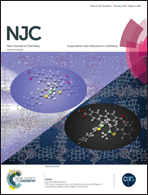Aggregation-induced emission enhancement and living cell imaging of novel diarylanthracene conjugated dyes†
Abstract
In this work, two novel diarylanthracene conjugated dyes, CzAn and BCzAn, which contain carbazolyl substituted triarylamine groups, were synthesized by the Ullmann reaction and characterized by 1H NMR, 13C NMR, and HRMS-MALDI-TOF. Both of the diarylanthracene conjugated dyes CzAn and BCzAn demonstrated aggregation-induced emission enhancement (AIEE) properties. CzAn and BCzAn emitted brightly in solid states with maximum emission wavelengths of 576 and 601 nm. BCzAn emitted weakly in THF solutions with a fluorescence quantum yield of 8%, became a strong emitter in the aggregate states with the fluorescence peak intensity increased in THF–water mixtures and DMF–glycerol mixtures rather than in pure solvents. Nanoparticles (Nps) were prepared from CzAn and BCzAn by a hydrophobic interaction with bovine serum albumin (BSA). The diameters of the AIEE dye based BSA nanoparticles were characterized by transmission electron microscopy (TEM) and their photophysical properties were also measured. These BSA nanoparticles showed high water dispersibility, stable uniform morphology (100–200 nm), strong fluorescence, low cytotoxicity and excellent biocompatibility, making them good optical materials for living HeLa cell imaging.


 Please wait while we load your content...
Please wait while we load your content...